Evaluation of the coaxiality of optical systems with large magnification on block cameras
The general tendency of observation weapons is the combination of
sensors in one device, allowing multispectral observation devices. This facilitates
flexible observation in different space, time and climate conditions. This type of
observation devices is often called multispectral observation devices, which can be
compact (hand-held) or an observation system. Multispectral observation devices
often consist of a daylight channel, a night channel using thermal imaging
technology or low light image intensifier systems in combanation with a laser
rangefinder module. In this article, the authors suggested a method for surveillance,
assessment and application of block cameras with the purpose of manufacturing
multispectral observation systems and devices.
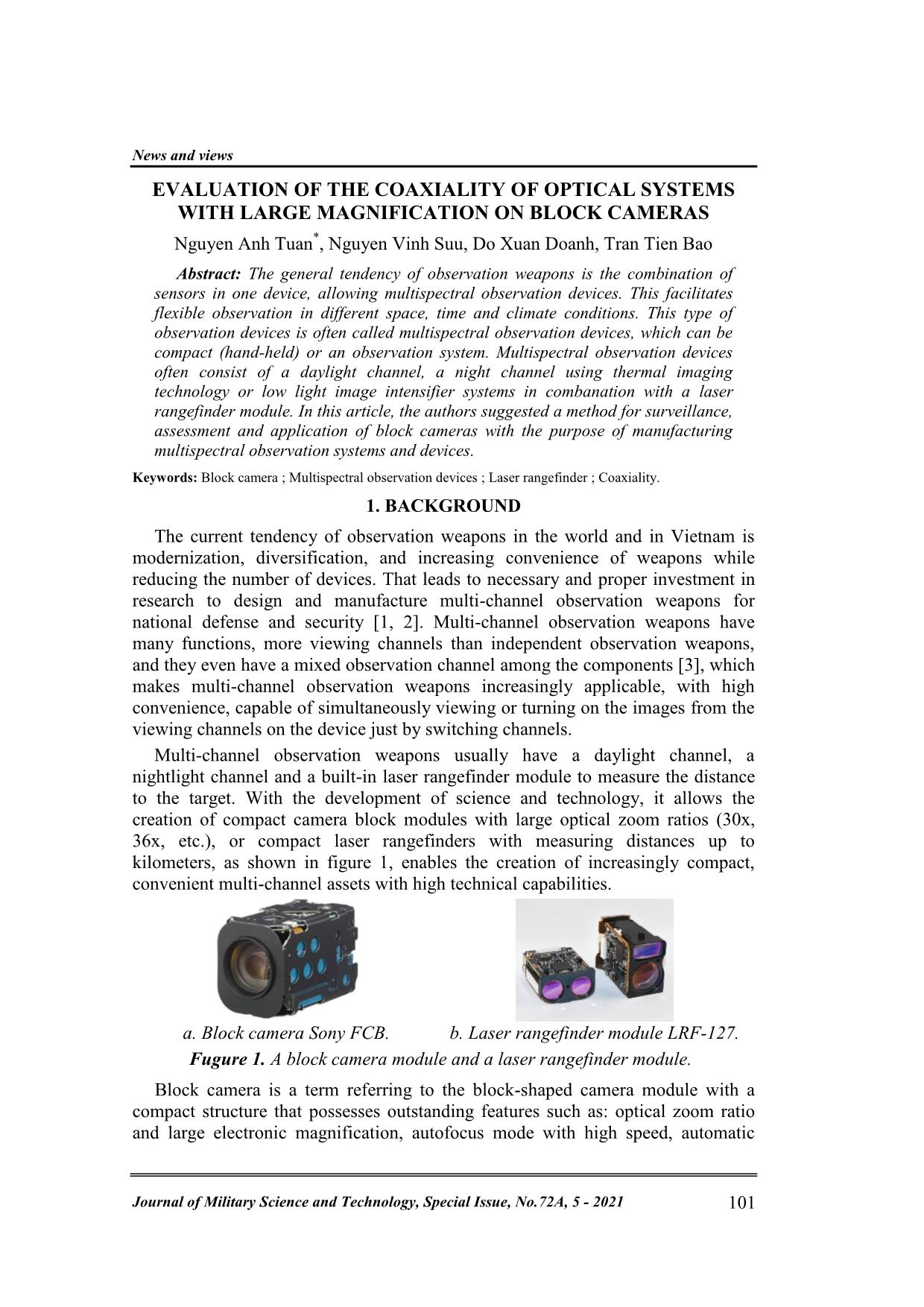
Trang 1

Trang 2
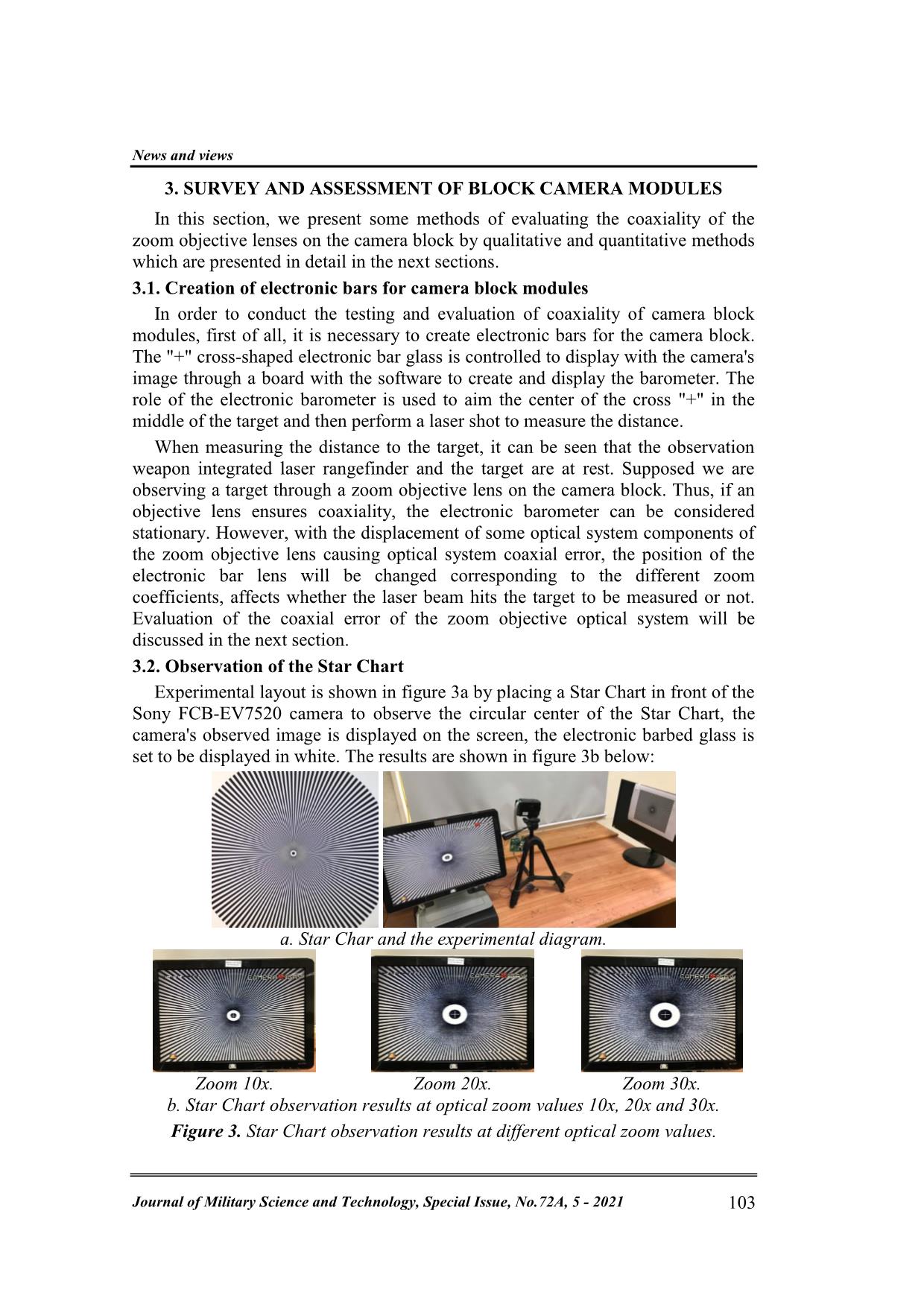
Trang 3
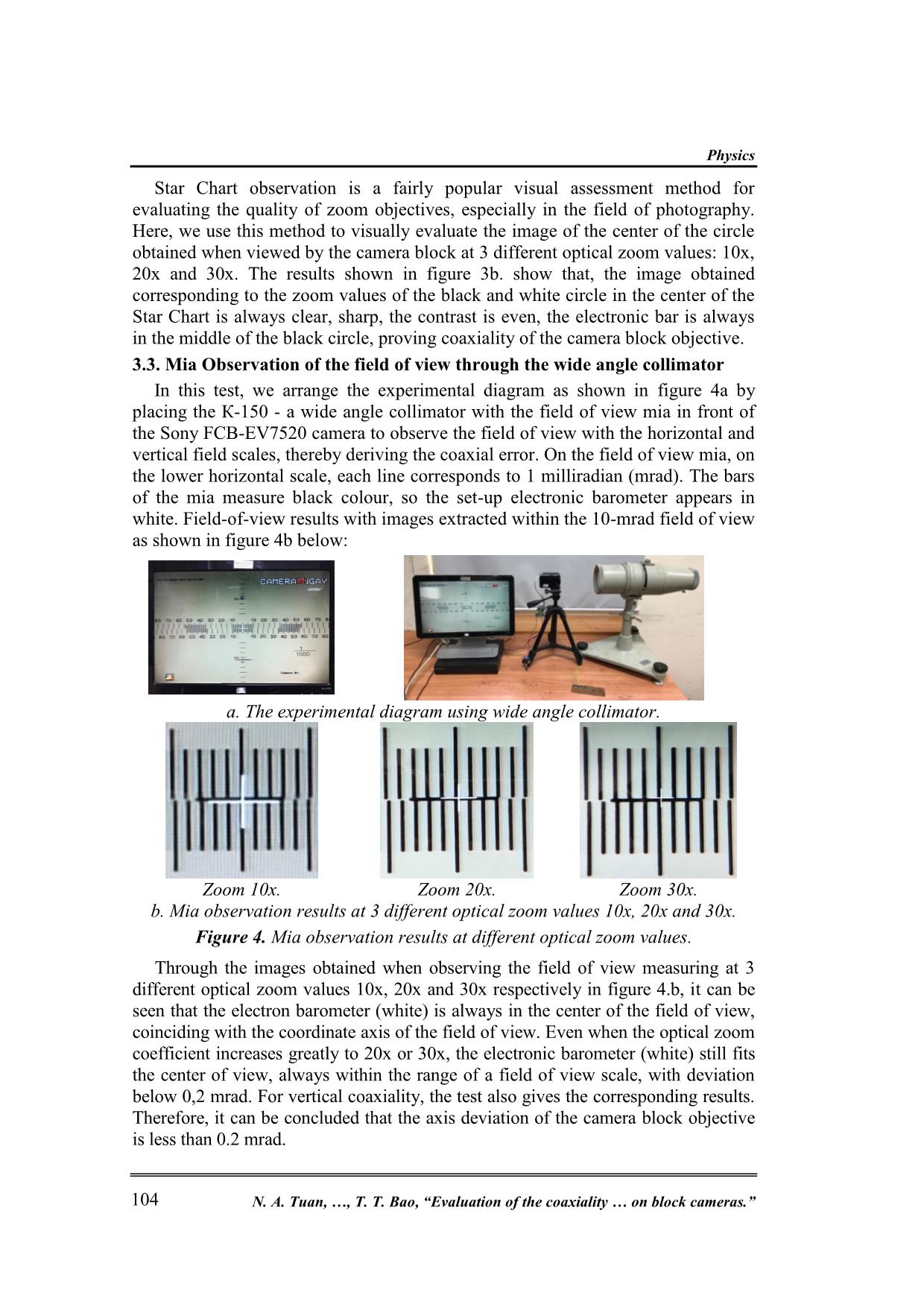
Trang 4
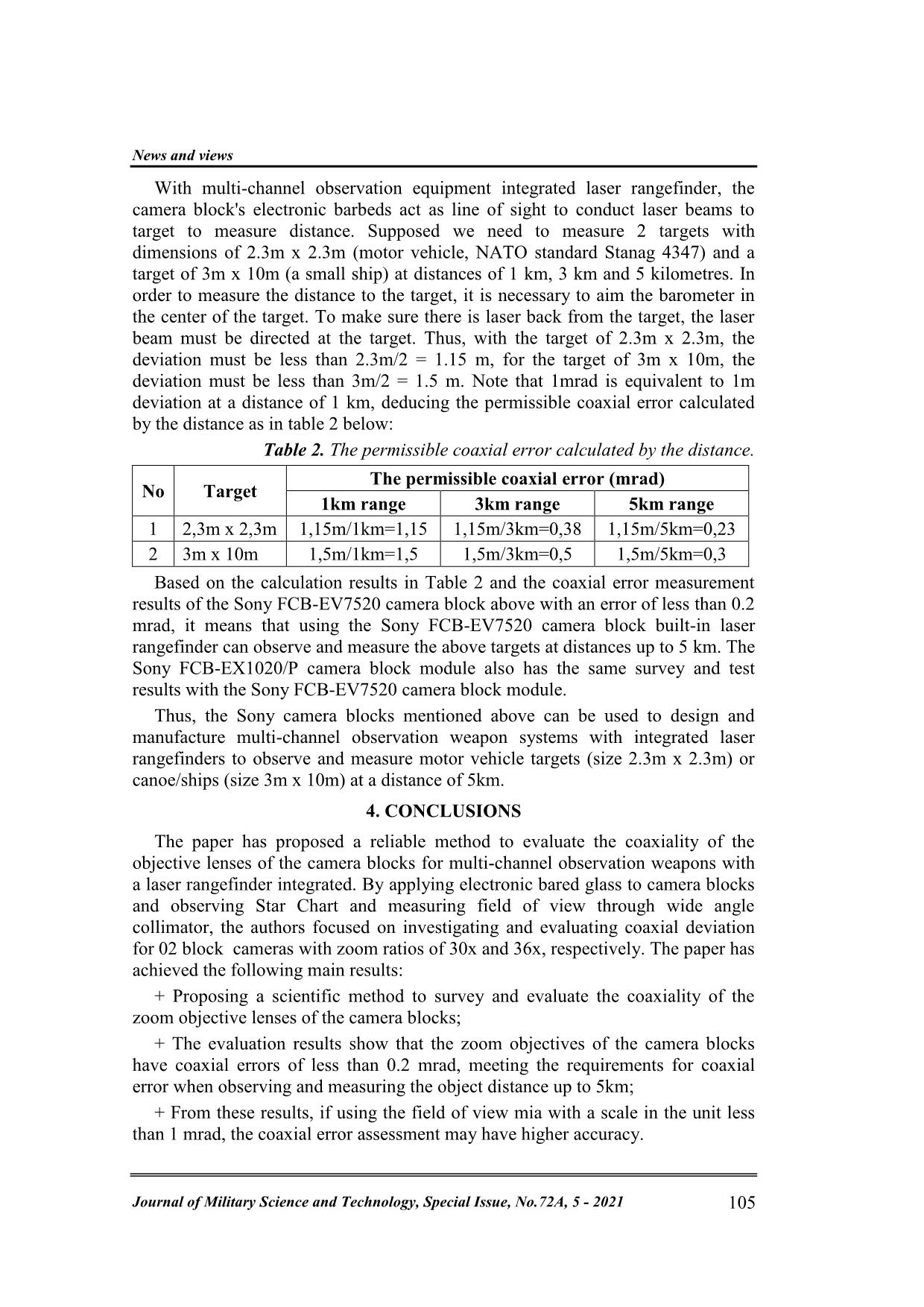
Trang 5
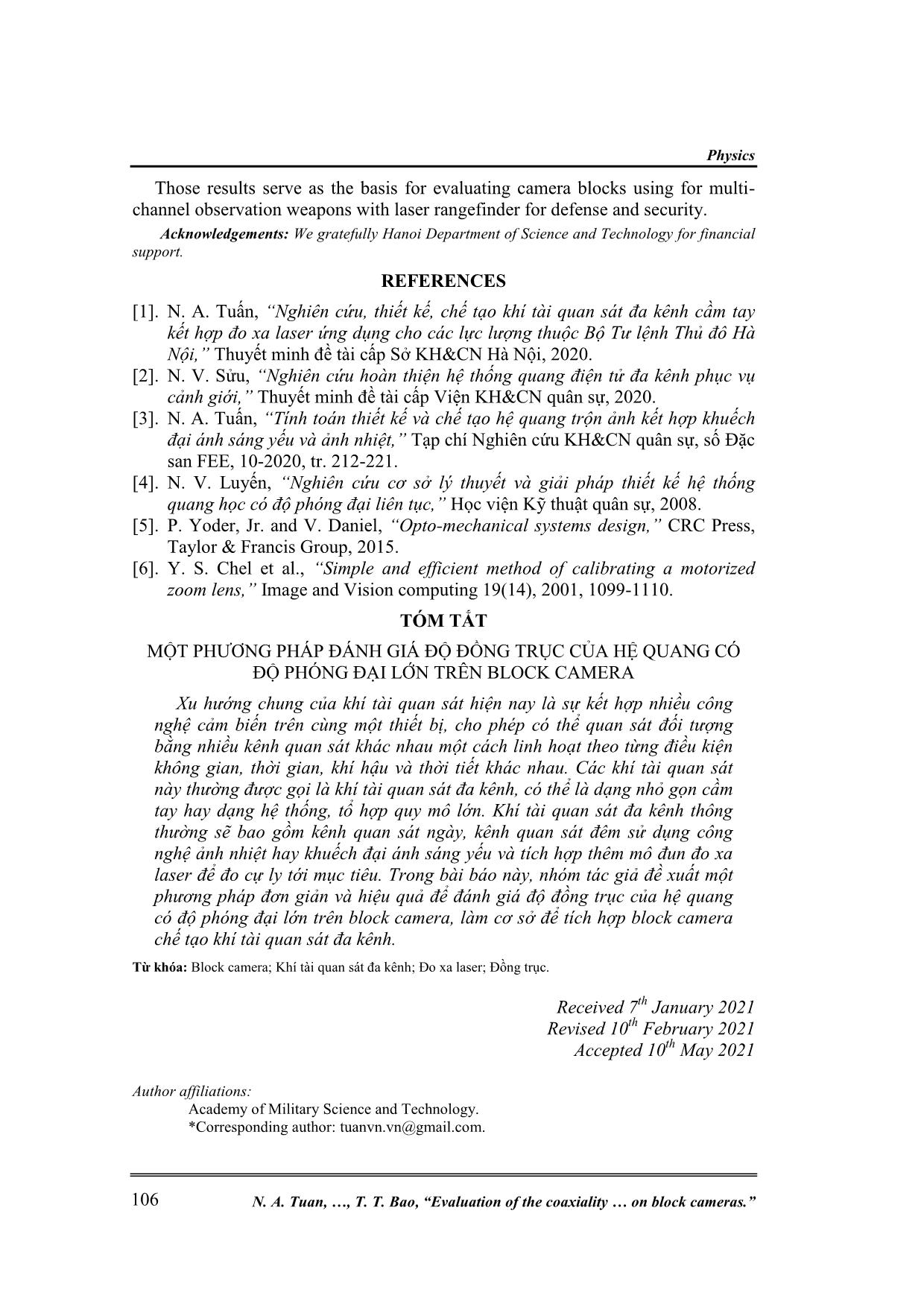
Trang 6
Tóm tắt nội dung tài liệu: Evaluation of the coaxiality of optical systems with large magnification on block cameras

ation of block cameras with the purpose of manufacturing multispectral observation systems and devices. Keywords: Block camera ; Multispectral observation devices ; Laser rangefinder ; Coaxiality. 1. BACKGROUND The current tendency of observation weapons in the world and in Vietnam is modernization, diversification, and increasing convenience of weapons while reducing the number of devices. That leads to necessary and proper investment in research to design and manufacture multi-channel observation weapons for national defense and security [1, 2]. Multi-channel observation weapons have many functions, more viewing channels than independent observation weapons, and they even have a mixed observation channel among the components [3], which makes multi-channel observation weapons increasingly applicable, with high convenience, capable of simultaneously viewing or turning on the images from the viewing channels on the device just by switching channels. Multi-channel observation weapons usually have a daylight channel, a nightlight channel and a built-in laser rangefinder module to measure the distance to the target. With the development of science and technology, it allows the creation of compact camera block modules with large optical zoom ratios (30x, 36x, etc.), or compact laser rangefinders with measuring distances up to kilometers, as shown in figure 1, enables the creation of increasingly compact, convenient multi-channel assets with high technical capabilities. a. Block camera Sony FCB. b. Laser rangefinder module LRF-127. Fugure 1. A block camera module and a laser rangefinder module. Block camera is a term referring to the block-shaped camera module with a compact structure that possesses outstanding features such as: optical zoom ratio and large electronic magnification, autofocus mode with high speed, automatic Journal of Military Science and Technology, Special Issue, No.72A, 5 - 2021 101 Physics brightness adjustment, etc. together with flexible control and customization, thus it is used to integrate into a variety of multi-channel observation equipment, hand- held devices or on the Drones, UAVs. In this paper, we chose the research object as a multi-channel observation weapon with laser rangefinder integrated, in which the daylight channel uses a camera block. With an objective lens with a high zoom factor, when changing the zoom coefficient, the optical-mechanical components of the optical system change continuously, causing a loss of optical coaxiality of the objective lenses, changing the image plane position due to displacement of optical system components [4]. Therefore, ensuring the coaxiality of the optical system block camera is crucial to hitting the target by laser rangefinder and measuring the distance to the target. This paper presents a method of evaluating the coaxiality of the zoom objective lenses of the camera blocks and draws conclusions about the suitability of camera blocks for multi-channel observation assets with a laser rangefinder integrated. 2. SELECTION OF BLOCK CAMERA MODULES In this section, the authors selected a number of camera block modules that have been commonly used and have a large optical zoom factor to conduct experiments to assess coaxiality when changing the optical zoom coefficients. 2.1. Selection of daylight camera block modules We selected 02 daylight camera block modules respectively: Sony FCB- EV7520 and Sony FCB-EX1020/P. These are camera blocks with high reliability, being studied and used for research projects in Vietnam [1, 2]. Some of the main technical features of the above camera block module are shown in Table 1 below. Table 1. Specifications of Sony block cameras. No Specifications FCB-EX1020/P Sony FCB-EV7520 1 Imge sensor 1/4 inch CCD 1/2,8 inch CMOS 2 Resolution, pixel 440.000 2,13 Megapixels 3 Optical/Digital zoom 36x/12x 30x/12x 4 Weight, g 230 255 2.2. Several reasons affecting the coaxiality of the objective lenses With the optical system with a large zoom coefficient, when changing the zoom factor, some components in the optical system will move, causing axis deviation, axis rotation or incorrect position compared to the standard position, leading to image dissipation [4-6] etc as shown in figure 2 below. a. Axis rotation. b. Defocus. Figure 2. Several reasons affecting the coaxiality of the objective lenses. 102 N. A. Tuan, , T. T. Bao, “Evaluation of the coaxiality on block cameras.” News and views 3. SURVEY AND ASSESSMENT OF BLOCK CAMERA MODULES In this section, we present some methods of evaluating the coaxiality of the zoom objective lenses on the camera block by qualitative and quantitative methods which are presented in detail in the next sections. 3.1. Creation of electronic bars for camera block modules In order to conduct the testing and evaluation of coaxiality of camera block modules, first of all, it is necessary to create electronic bars for the camera block. The "+" cross-shaped electronic bar glass is controlled to display with the camera's image through a board with the software to create and display the barometer. The role of the electronic barometer is used to aim the center of the cross "+" in the middle of the target and then perform a laser shot to measure the distance. When measuring the distance to the target, it can be seen that the observation weapon integrated laser rangefinder and the target are at rest. Supposed we are observing a target through a zoom objective lens on the camera block. Thus, if an objective lens ensures coaxiality, the electronic barometer can be considered stationary. However, with the displacement of some optical system components of the zoom objective lens causing optical system coaxial error, the position of the electronic bar lens will be changed corresponding to the different zoom coefficients, affects whether the laser beam hits the target to be measured or not. Evaluation of the coaxial error of the zoom objective optical system will be discussed in the next section. 3.2. Observation of the Star Chart Experimental layout is shown in figure 3a by placing a Star Chart in front of the Sony FCB-EV7520 camera to observe the circular center of the Star Chart, the camera's observed image is displayed on the screen, the electronic barbed glass is set to be displayed in white. The results are shown in figure 3b below: a. Star Char and the experimental diagram. Zoom 10x. Zoom 20x. Zoom 30x. b. Star Chart observation results at optical zoom values 10x, 20x and 30x. Figure 3. Star Chart observation results at different optical zoom values. Journal of Military Science and Technology, Special Issue, No.72A, 5 - 2021 103 Physics Star Chart observation is a fairly popular visual assessment method for evaluating the quality of zoom objectives, especially in the field of photography. Here, we use this method to visually evaluate the image of the center of the circle obtained when viewed by the camera block at 3 different optical zoom values: 10x, 20x and 30x. The results shown in figure 3b. show that, the image obtained corresponding to the zoom values of the black and white circle in the center of the Star Chart is always clear, sharp, the contrast is even, the electronic bar is always in the middle of the black circle, proving coaxiality of the camera block objective. 3.3. Mia Observation of the field of view through the wide angle collimator In this test, we arrange the experimental diagram as shown in figure 4a by placing the К-150 - a wide angle collimator with the field of view mia in front of the Sony FCB-EV7520 camera to observe the field of view with the horizontal and vertical field scales, thereby deriving the coaxial error. On the field of view mia, on the lower horizontal scale, each line corresponds to 1 milliradian (mrad). The bars of the mia measure black colour, so the set-up electronic barometer appears in white. Field-of-view results with images extracted within the 10-mrad field of view as shown in figure 4b below: a. The experimental diagram using wide angle collimator. Zoom 10x. Zoom 20x. Zoom 30x. b. Mia observation results at 3 different optical zoom values 10x, 20x and 30x. Figure 4. Mia observation results at different optical zoom values. Through the images obtained when observing the field of view measuring at 3 different optical zoom values 10x, 20x and 30x respectively in figure 4.b, it can be seen that the electron barometer (white) is always in the center of the field of view, coinciding with the coordinate axis of the field of view. Even when the optical zoom coefficient increases greatly to 20x or 30x, the electronic barometer (white) still fits the center of view, always within the range of a field of view scale, with deviation below 0,2 mrad. For vertical coaxiality, the test also gives the corresponding results. Therefore, it can be concluded that the axis deviation of the camera block objective is less than 0.2 mrad. 104 N. A. Tuan, , T. T. Bao, “Evaluation of the coaxiality on block cameras.” News and views With multi-channel observation equipment integrated laser rangefinder, the camera block's electronic barbeds act as line of sight to conduct laser beams to target to measure distance. Supposed we need to measure 2 targets with dimensions of 2.3m x 2.3m (motor vehicle, NATO standard Stanag 4347) and a target of 3m x 10m (a small ship) at distances of 1 km, 3 km and 5 kilometres. In order to measure the distance to the target, it is necessary to aim the barometer in the center of the target. To make sure there is laser back from the target, the laser beam must be directed at the target. Thus, with the target of 2.3m x 2.3m, the deviation must be less than 2.3m/2 = 1.15 m, for the target of 3m x 10m, the deviation must be less than 3m/2 = 1.5 m. Note that 1mrad is equivalent to 1m deviation at a distance of 1 km, deducing the permissible coaxial error calculated by the distance as in table 2 below: Table 2. The permissible coaxial error calculated by the distance. The permissible coaxial error (mrad) No Target 1km range 3km range 5km range 1 2,3m x 2,3m 1,15m/1km=1,15 1,15m/3km=0,38 1,15m/5km=0,23 2 3m x 10m 1,5m/1km=1,5 1,5m/3km=0,5 1,5m/5km=0,3 Based on the calculation results in Table 2 and the coaxial error measurement results of the Sony FCB-EV7520 camera block above with an error of less than 0.2 mrad, it means that using the Sony FCB-EV7520 camera block built-in laser rangefinder can observe and measure the above targets at distances up to 5 km. The Sony FCB-EX1020/P camera block module also has the same survey and test results with the Sony FCB-EV7520 camera block module. Thus, the Sony camera blocks mentioned above can be used to design and manufacture multi-channel observation weapon systems with integrated laser rangefinders to observe and measure motor vehicle targets (size 2.3m x 2.3m) or canoe/ships (size 3m x 10m) at a distance of 5km. 4. CONCLUSIONS The paper has proposed a reliable method to evaluate the coaxiality of the objective lenses of the camera blocks for multi-channel observation weapons with a laser rangefinder integrated. By applying electronic bared glass to camera blocks and observing Star Chart and measuring field of view through wide angle collimator, the authors focused on investigating and evaluating coaxial deviation for 02 block cameras with zoom ratios of 30x and 36x, respectively. The paper has achieved the following main results: + Proposing a scientific method to survey and evaluate the coaxiality of the zoom objective lenses of the camera blocks; + The evaluation results show that the zoom objectives of the camera blocks have coaxial errors of less than 0.2 mrad, meeting the requirements for coaxial error when observing and measuring the object distance up to 5km; + From these results, if using the field of view mia with a scale in the unit less than 1 mrad, the coaxial error assessment may have higher accuracy. Journal of Military Science and Technology, Special Issue, No.72A, 5 - 2021 105 Physics Those results serve as the basis for evaluating camera blocks using for multi- channel observation weapons with laser rangefinder for defense and security. Acknowledgements: We gratefully Hanoi Department of Science and Technology for financial support. REFERENCES [1]. N. A. Tuấn, “Nghiên cứu, thiết kế, chế tạo khí tài quan sát đa kênh cầm tay kết hợp đo xa laser ứng dụng cho các lực lượng thuộc Bộ Tư lệnh Thủ đô Hà Nội,” Thuyết minh đề tài cấp Sở KH&CN Hà Nội, 2020. [2]. N. V. Sửu, “Nghiên cứu hoàn thiện hệ thống quang điện tử đa kênh phục vụ cảnh giới,” Thuyết minh đề tài cấp Viện KH&CN quân sự, 2020. [3]. N. A. Tuấn, “Tính toán thiết kế và chế tạo hệ quang trộn ảnh kết hợp khuếch đại ánh sáng yếu và ảnh nhiệt,” Tạp chí Nghiên cứu KH&CN quân sự, số Đặc san FEE, 10-2020, tr. 212-221. [4]. N. V. Luyến, “Nghiên cứu cơ sở lý thuyết và giải pháp thiết kế hệ thống quang học có độ phóng đại liên tục,” Học viện Kỹ thuật quân sự, 2008. [5]. P. Yoder, Jr. and V. Daniel, “Opto-mechanical systems design,” CRC Press, Taylor & Francis Group, 2015. [6]. Y. S. Chel et al., “Simple and efficient method of calibrating a motorized zoom lens,” Image and Vision computing 19(14), 2001, 1099-1110. TÓM TẮT MỘT PHƯƠNG PHÁP ĐÁNH GIÁ ĐỘ ĐỒNG TRỤC CỦA HỆ QUANG CÓ ĐỘ PHÓNG ĐẠI LỚN TRÊN BLOCK CAMERA Xu hướng chung của khí tài quan sát hiện nay là sự kết hợp nhiều công nghệ cảm biến trên cùng một thiết bị, cho phép có thể quan sát đối tượng bằng nhiều kênh quan sát khác nhau một cách linh hoạt theo từng điều kiện không gian, thời gian, khí hậu và thời tiết khác nhau. Các khí tài quan sát này thường được gọi là khí tài quan sát đa kênh, có thể là dạng nhỏ gọn cầm tay hay dạng hệ thống, tổ hợp quy mô lớn. Khí tài quan sát đa kênh thông thường sẽ bao gồm kênh quan sát ngày, kênh quan sát đêm sử dụng công nghệ ảnh nhiệt hay khuếch đại ánh sáng yếu và tích hợp thêm mô đun đo xa laser để đo cự ly tới mục tiêu. Trong bài báo này, nhóm tác giả đề xuất một phương pháp đơn giản và hiệu quả để đánh giá độ đồng trục của hệ quang có độ phóng đại lớn trên block camera, làm cơ sở để tích hợp block camera chế tạo khí tài quan sát đa kênh. Từ khóa: Block camera; Khí tài quan sát đa kênh; Đo xa laser; Đồng trục. Received 7th January 2021 Revised 10th February 2021 Accepted 10th May 2021 Author affiliations: Academy of Military Science and Technology. *Corresponding author: tuanvn.vn@gmail.com. 106 N. A. Tuan, , T. T. Bao, “Evaluation of the coaxiality on block cameras.”
File đính kèm:
 evaluation_of_the_coaxiality_of_optical_systems_with_large_m.pdf
evaluation_of_the_coaxiality_of_optical_systems_with_large_m.pdf

